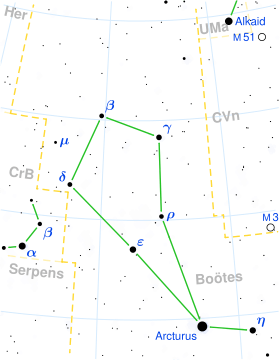12 Boötis
| Observation data Epoch J2000 Equinox J2000 | |
|---|---|
| Constellation | Boötes |
| Right ascension | 14h 10m 23.93342s[1] |
| Declination | 25° 05′ 30.0394″[1] |
| Apparent magnitude (V) | 4.83[2] |
| Characteristics | |
| Spectral type | F9IVw[3] |
| U−B color index | +0.07[2] |
| B−V color index | +0.54[2] |
| Astrometry | |
| Radial velocity (Rv) | +9.58[4] km/s |
| Proper motion (μ) | RA: -23.43[1] mas/yr Dec.: -59.79[1] mas/yr |
| Parallax (π) | 26.72 ± 0.21[1] mas |
| Distance | 122.1 ± 1.0 ly (37.4 ± 0.3 pc) |
| Absolute magnitude (MV) | 1.95[5] |
| Details | |
| Mass | 1.63[6] M☉ |
| Radius | 2.9[6] R☉ |
| Luminosity | 14.53[5] L☉ |
| Surface gravity (log g) | 3.73[6] cgs |
| Temperature | 6,310[6] K |
| Metallicity [Fe/H] | +0.02[5] dex |
| Rotational velocity (v sin i) | 15.0[7] km/s |
| Other designations | |
| Database references | |
| SIMBAD | data |
12 Boötis is a spectroscopic binary[8] in the constellation Boötes. It is approximately 122 light years from Earth.[1]
The primary component, 12 Boötis A, is a yellow-white F-type subgiant with an apparent magnitude of +4.82. The spectroscopic binary pair completes one orbit around its centre of mass once every 9.6045 days,[3] with an estimated separation of 0.0035".[9] A companion, 12 Boötis B, was reported with a separation of approximately one arcsecond in 1989, but subsequent surveys have repeatedly failed to detect this companion.[3]
References
- 1 2 3 4 5 6 Van Leeuwen, F. (2007). "Validation of the new Hipparcos reduction". Astronomy and Astrophysics. 474 (2): 653. arXiv:0708.1752
 . Bibcode:2007A&A...474..653V. doi:10.1051/0004-6361:20078357. Vizier catalog entry
. Bibcode:2007A&A...474..653V. doi:10.1051/0004-6361:20078357. Vizier catalog entry - 1 2 3 Ducati, J. R. (2002). "VizieR Online Data Catalog: Catalogue of Stellar Photometry in Johnson's 11-color system". CDS/ADC Collection of Electronic Catalogues. 2237. Bibcode:2002yCat.2237....0D.
- 1 2 3 Mason, Brian D.; Wycoff, Gary L.; Hartkopf, William I.; Douglass, Geoffrey G.; Worley, Charles E. (2001). "The 2001 US Naval Observatory Double Star CD-ROM. I. The Washington Double Star Catalog". The Astronomical Journal. 122 (6): 3466. Bibcode:2001AJ....122.3466M. doi:10.1086/323920. Vizier catalog entry
- ↑ Pourbaix, D.; Tokovinin, A. A.; Batten, A. H.; Fekel, F. C.; Hartkopf, W. I.; Levato, H.; Morrell, N. I.; Torres, G.; Udry, S. (2004). "SB9: The ninth catalogue of spectroscopic binary orbits". Astronomy and Astrophysics. 424 (2): 727. arXiv:astro-ph/0406573
 . Bibcode:2004A&A...424..727P. doi:10.1051/0004-6361:20041213.
. Bibcode:2004A&A...424..727P. doi:10.1051/0004-6361:20041213. - 1 2 3 Anderson, E.; Francis, Ch. (2012). "XHIP: An extended hipparcos compilation". Astronomy Letters. 38 (5): 331. arXiv:1108.4971
 . Bibcode:2012AstL...38..331A. doi:10.1134/S1063773712050015. Vizier catalog entry
. Bibcode:2012AstL...38..331A. doi:10.1134/S1063773712050015. Vizier catalog entry - 1 2 3 4 Allende Prieto, C.; Lambert, D. L. (1999). "Fundamental parameters of nearby stars from the comparison with evolutionary calculations: Masses, radii and effective temperatures". Astronomy and Astrophysics. 352: 555. arXiv:astro-ph/9911002
 . Bibcode:1999A&A...352..555A. Vizier catalog entry
. Bibcode:1999A&A...352..555A. Vizier catalog entry - ↑ Glebocki, R.; Gnacinski, P. (2005). "VizieR Online Data Catalog: Catalog of Stellar Rotational Velocities (Glebocki+ 2005)". VizieR On-line Data Catalog: III/244. Originally published in: 2005csss...13..571G; 2005yCat.3244....0G. 3244. Bibcode:2005yCat.3244....0G. Vizier catalog entry
- ↑ Konacki, Maciej; et al. (2010). "High-precision Orbital and Physical Parameters of Double-lined Spectroscopic Binary Stars—HD78418, HD123999, HD160922, HD200077, and HD210027". The Astrophysical Journal. 719 (2): 1293–1314. arXiv:0910.4482
 . Bibcode:2010ApJ...719.1293K. doi:10.1088/0004-637X/719/2/1293.
. Bibcode:2010ApJ...719.1293K. doi:10.1088/0004-637X/719/2/1293. - ↑ Malkov, O. Yu.; Tamazian, V. S.; Docobo, J. A.; Chulkov, D. A. (2012). "Dynamical masses of a selected sample of orbital binaries". Astronomy & Astrophysics. 546: A69. Bibcode:2012A&A...546A..69M. doi:10.1051/0004-6361/201219774. Vizier catalog entry
This article is issued from Wikipedia - version of the 9/9/2016. The text is available under the Creative Commons Attribution/Share Alike but additional terms may apply for the media files.
